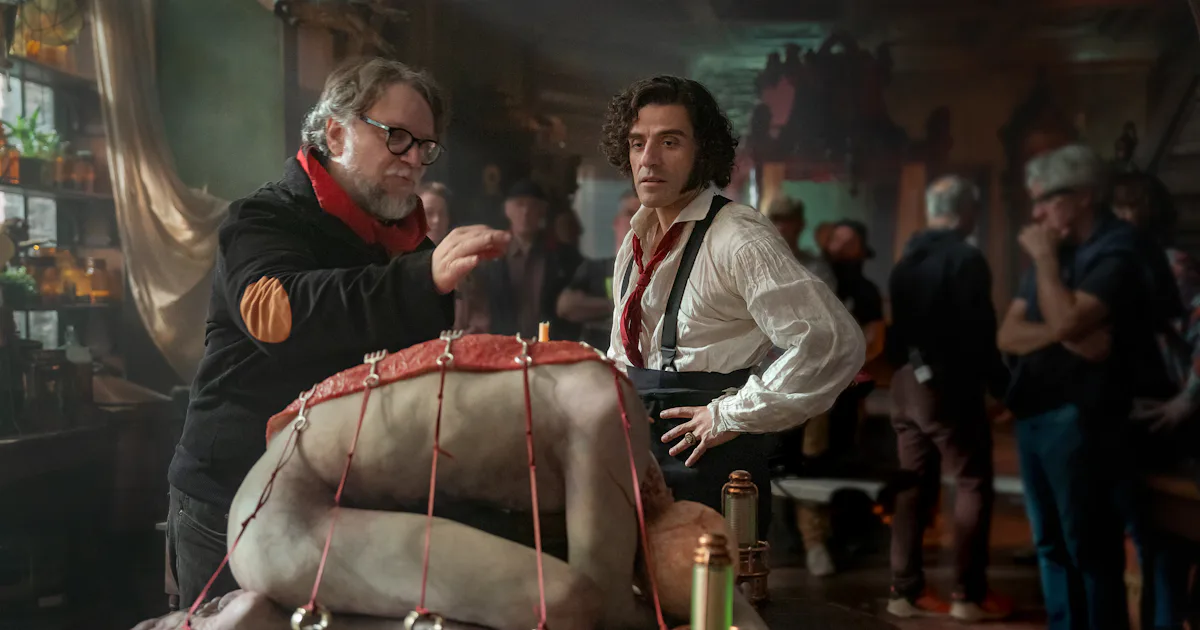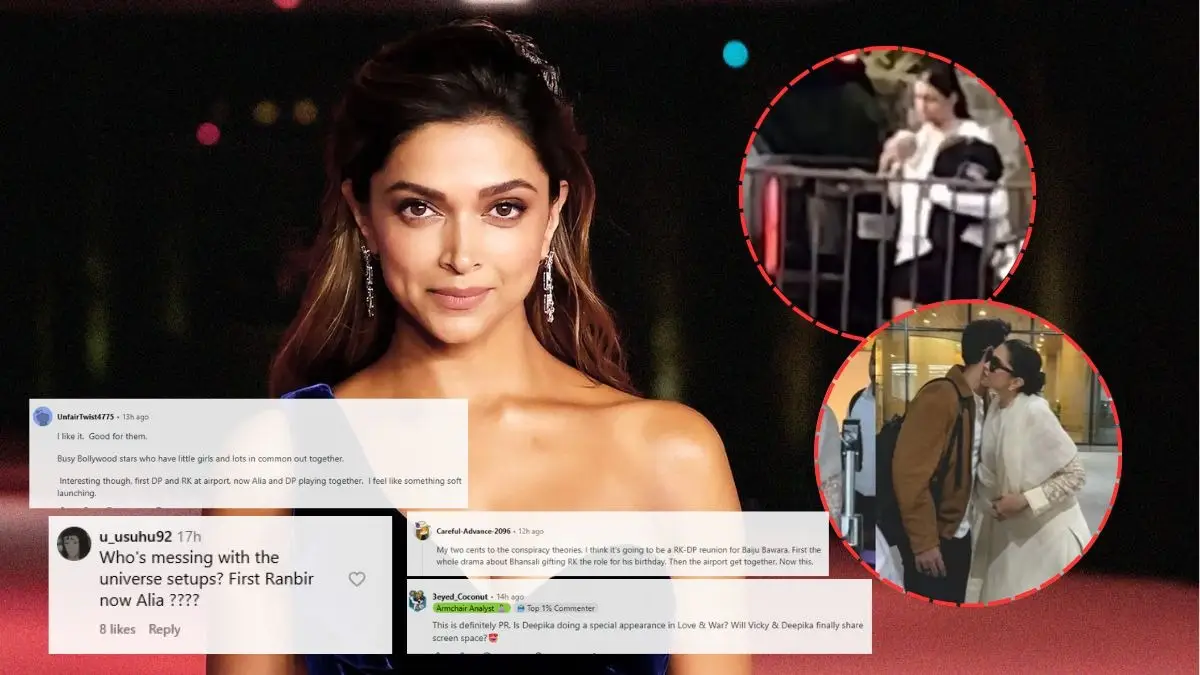Copyright Inverse

In any film by Guillermo del Toro, the relationship between hero and villain is flipped grotesquely on its head. To find your bad guy, you needn’t look further than the handsome man in the impeccably tailored suit: Think Sergi López’s Captain Vidal in Pan’s Labyrinth, or Tom Hiddleston’s Sir Thomas Sharpe in Crimson Peak. Guillermo del Toro always wants us to root for the monster — but Frankenstein tells a slightly more nuanced story. When it comes to the archetypal del Toro antagonist, Oscar Isaac’s Victor Frankenstein easily fits the bill. The director has described him as a “Byronic rock star,” with all the pride and pomp that status befits. He’s called a monster not once, but twice, each by people he cares deeply for. And, perhaps most obviously, he abuses the very being his science brings into the world, a gentle Creature (played by a transcendent Jacob Elordi) who learns about the perils of existence first from Victor’s own hand. If this dynamic were not so foundational to Mary Shelley’s original text — and if del Toro didn’t take such pleasure in unraveling it — his Frankenstein would err on the side of unsubtle. But the film is far from an open-and-shut case on the making of a monster. Both Creature and creator spend as much time in the light as they do in the dark; Del Toro takes his time exploring how each was twisted by circumstance into shapes unrecognizable. Yes, his dialogue might lay out their plights in broad, unmistakable strokes, but the world the director and his artisans build around those words is the story we should really be listening to. Costumes by Kate Hawley and creature effects by Mike Hill, both longtime collaborators of del Toro’s, craft a tale as beautiful as it is tragic, elevating a typical clash of “man vs. monster” into one of the year’s most breathtaking films. The primal wound Frankenstein subtly shifts the timeline of Shelley’s original story, setting the scene in the Victorian era rather than the Age of Enlightenment. That allowed Hawley to explore slightly more modern flourishes for characters like Victor. Del Toro was adamant about avoiding any period garb that felt too stuffy or would mold his cast into caricatures of the era. “Guillermo [was] like, ’I don’t want the sea of black hats and fusty period stuff,’” Hawley tells Inverse. The team workshopped “a more modern feel,” citing Hammer Films’ gothic horrors made between the 1950s and the 1970s. “In the ’60s there was a sort of Victorian dandy world, and that kind of crosses over back again into the 1850s, [so] we looked at lots of different characters as reference.” That influence is clearest with Victor’s chosen wardrobe. In flashbacks to the past, he’s dressed in that stuffy attire that defined the era; in adulthood, he shirks his aristocratic roots entirely. Victor “has a wardrobe of beautiful things from the past,” Hawley says. “But he wears it irreverently.” David Bowie’s mid ’70s persona, the Thin White Duke, provided some foundation for Victor’s uniform, while Soviet ballet dancer Rudolf Nureyev and his affinity for “beautiful 18th-century furniture” inspired the doctor’s workspace. Together, those influences created a fascinating dichotomy between the sacred and profane. “He wears [his clothes] to work in the lab,” Hawley adds. “He doesn’t go and get dressed in his science smock and becomes Dr. Frankenstein.” He’s an artist in the same way that Picasso or Damien Hirst is an artist: “Their clothes are covered in the work that they do. In [Victor’s] case, possibly acid and viscera.” There’s also plenty of blood, which manifests literally on his person as he works to build his Creature, but also figuratively. The color red is a defining quality of any del Toro film: It connects to the primal, maternal wound, the trauma and mortality of giving birth. Hawley used what she calls “pigeon blood red” to personify the ghosts that haunt Victor, namely his mother Claire (Mia Goth), whom he lost in his youth. “There was some backstory in one of the scripts and character beats that Guillermo said,” says Hawley, “talking about Victor’s fear of blood, but also being part of it.” That links him to the Angel of Death that visits in his dreams, and also to his unrequited love, Elizabeth (also Goth) — but it all begins with Claire. Victor’s mother is the focal point, the root of his complexes (his preference for milk, especially) and his eventual obsession with controlling and creating life. Her face is a hazy memory — Hawley obscures it with a veil, while Hill added prosthetics to Goth’s brow and nose to create a resemblance with Isaac — but he vividly remembers her voice, her red dress, and her blood on his white shirt just before she perishes in childbirth. Even if he masters his fear of blood by becoming a surgeon, it follows Victor whether he’d like it to or not. Claire’s bloody handprints become Victor’s red leather gloves; the red scarf around his neck is almost like a bloody albatross. The red accents in her coffin are echoed in Elizabeth’s red bonnet. It’s a brilliant motif, but no less tragic, and it all gets worse for Victor once he brings the Creature to life. The Creature’s tale It’s impossible to talk about the Creature without mentioning his recasting. The role once belonged to Andrew Garfield, but a last-minute scheduling conflict forced him to drop out of Frankenstein in 2023, just nine weeks before production was set to begin. Elordi had just a few weeks to accept the role and prepare, but Mike Hill — the designer who crafted The Shape of Water’s comely fish prince, among other creatures — had to scrap his design for Garfield and start completely from scratch. At six foot five, Elordi is a much bigger canvas: None of the prosthetics created for Garfield could be repurposed. But Elordi, in other ways, proved to be the perfect specimen. “Don’t get me wrong, the first actor was a great guy, and we would’ve made a great creature,” Hill tells Inverse of Garfield. “But Jacob just has… there’s something about his demeanor, and we all talk about his physicality being perfect, being six foot five [with] big eyes and big eyelids.” Elordi also had “the patience of a saint.” Each day, Hill spent up to 10 hours applying as many as 42 prosthetics to his person, a job that usually began late at night and took them into the morning. “I never got one single complaint,” Hill says, “and for that reason, I never left my actor’s side.” Despite the crunch, Hill seems to have gotten through the redesign without much difficulty. “I had Guillermo telling me what he doesn’t want, which is a really good way to work because then you don’t waste your time.” He and del Toro share an affinity for Boris Karloff’s Creature — a life-size model of Karloff in full makeup sits behind Hill when he speaks to me over Zoom. But anything too similar to that design wouldn’t have gelled with this particular retelling. “Reference-wise, we looked at wax statues and alabaster statues of the period, and I looked at a lot of, obviously, medical procedures of the period. Even though this is pure fantasy, I still wanted to route it and see how naive their techniques were at the time.” Hill had to step into Victor’s shoes when designing the Creature: “Things like phrenology heads [from] the time… they were pottery heads and they had the lines drawn on them. I looked at that and thought, ’Maybe Victor refers too closely to that,’” Hill says. “It’s absurd that he would follow it, [but] it is that fine lining fantasy; what’s going to look good.” He also avoided any designs that gave the impression of a “repair job.” Victor’s work is purposeful, an attempt (however perverse) to recreate the beauty of nature. In a certain light, the Creature veers a little too close to nature, leaning almost animalistic. A happy accident with an errant contact lens — designed to make Elordi’s eyes “even bigger,” more innocent, and doe-like — helped embody that polarity. “Jacob, on day one, got irritated by one of them, so we took it out,” Hill says. Del Toro decided he liked the mismatched look. “In the novel, Shelley says that Victor visited slaughterhouses and mortuaries,” explains Hill. “We figured maybe this might be an animal’s eye that he’s got on this side.” Del Toro would focus on the left of Elordi’s face (complete with a glowing yellow-red eye, rendered in post-production) whenever the Creature embraced his “scary side.” The Creature’s skin, meanwhile, Hill likens to an insect — no doubt a nod to his relationship with Elizabeth (also Goth), who studies and loves bugs. “I wanted it to look like porcelain or ivory, or Guillermo liked alabaster’s look,” continues Hill. Crucially, he didn’t have to choose between one or the other, instead going for a multicolored effect. “Maybe Frankenstein had done a color-by-numbers, and he dyed these pieces different colors to be able to patch them in the right order.” When the Creature first comes to life and Victor flings open the curtains to bask with him in sunlight, he’s almost “like a butterfly.” As his journey progresses and he’s worn down by the world, he gets “a bit darker and dirtier,” more like a moth. Back to the beginning Throughout Frankenstein, there’s this romantic ideal of religion comingling with nature. The Creature’s costumes invoked Christian imagery — the loincloth and bandages he’s essentially “born” in were allusions to Christ’s crucifixion — but also to an undead coming of age. “I’d been looking at a lot of mummified clothing, buried bodies,” Hawley says. “They sort of take on the form of the body; the clothes mold to the skeleton as it disintegrates.” That’s best exemplified in the first item of clothing the Creature chooses for himself: A mossy, tattered jacket he takes from the skeleton of a soldier who fought in the Crimean War. “For me, it was almost like he was wearing the memory of another man on him,” Hawley explains. “I had to look at what Mike was doing with all his creature prosthetics and the form and the body coming through, and then I sort of accentuated it. You should have seen us bringing in leftover bones and trying to create vertebrae and molding them into the leather.” “Kate is taking what I did on the inside and put it outside,” adds Hill. “There’s rib cages and stuff in other outfits in the movie if you look close.” When it comes to character, del Toro’s department heads work from the inside out — but according to Hawley, del Toro also “tells his story in circles.” Victor’s journey reflects a kind of return to the Mother as he grapples with the burden of parenthood, while the Creature works to return to the light. It makes Frankenstein more spiritual than your garden-variety monster movie, and gives audiences a great deal more to chew on. Frankenstein is now streaming on Netflix.



